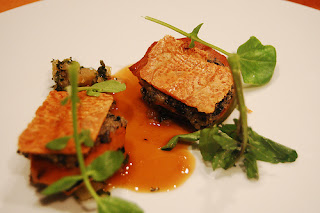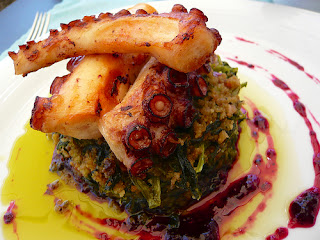from
Behind the French Menu
by
Bryan G. Newman
behindthefrenchmenu@gmail.com
Botanique on the Rocks
Sucs en Herbe
www.flickr.com/photos/clubsodaguide/34924215243/
Sucs de Cuisson - Cooking Juices.
Sucs de Plantes Fraîches - The juices of fresh plants
Sucs de Plantes Bio – The juices of organically farmed plants
Sucs en Herbe - The juices from herbs and spices.
Suc is pronounced sook.
Suc or sucs will be on the menu when the chef is using cooking juices of all kinds. French cuisine revels in the pure, clear taste that the juice from plants and herbs provide. These juices provide tastes that the whole plant hides and they may be the heart of a masterpiece. Other tastes come from the sucs de cuisson, the cooking juices of meats, poultry, seafood or fish.
Some plants overflow with juice, like the tomato. On a menu listing, the chef may decide to call the juice, sucs de tomate, rather than the less exciting name jus de tomate. Nevertheless, most plant-based sucs, juices, are not as easily obtained as tomato juice.
Suc on French Menus:
Bœuf Black Angus Grillé, aux Herbes et Suc à l'Estragon – A grilled Black Angus steak flavored with herbs and tarragon juice.
Tarragon ice cream, black currant mousse.
www.flickr.com/photos/familyclan/15931344416/
Carpaccio de Langoustines Fumées, Brunoise de Légumes, Glace aux Sucs de Carapaces – A carpaccio made from the smoked meat of Dublin Bay Prawns, the real scampi, served with vegetables prepared in cubes and glazed with the juices from the shells of crustaceans. (French cuisine has rules that determine the exact way vegetables should be cut. Each cut has a name that represents a different size or shape, and most French diners know them all. Brunoise indicates cubes 5mm x 5mm x 5mm).
Côte de Veau de Dordogne, Morilles Crémées, Amandes, Oseille, Sucs de Cuisson – A bone-in rib steak of veal from the Dordogne served with a sauce made from creamed morel mushrooms, almonds, sorrel, and the veal's natural cooking juices.
Mackerel with garlic sauce and lemon juice
Filet de Bar Rôti aux Sucs de Crustacés et Linguine – Roasted European sea bass flavored with juices from the shells of crustaceans and served with linguine. (Linguine is the oval-shaped pasta that looks somewhat like flattened spaghetti).
Noix de St-Jacques Dieppoise à la Plancha, Gnocchi Frais aux Sucs de Truffes – Meat of the king scallop brought from the fishing port of Dieppe, on the coast of Normandy, braised on the plancha and served with fresh gnocchi flavored with truffle juices.
www.flickr.com/photos/nooks/2946414394/
Soufflé Glacé au Grand Marnier et Sucs d'Agrumes – A soufflé glazed with Grand Manier and flavored with citrus juices.
Outside of France, some diners believe that French chefs take the very best of everything and throw a lot away. That is not true. French chefs work hard to make their creations taste differently with scents that will make your mouth water. They use fruits and vegetables from their peel to their pips, their pits. The cooking juices from meats, poultry, seafood, and fish are also used. Chefs will scrape the sugars and the browned pieces left in a roasting dishes or frying pans and use them to make sauces, the sucs de cuisson.
Braised abaloni, pear and abalone juices,
www.flickr.com/photos/34338566@N08/5534543757/
Connected Posts :
Bar or Loup - European Sea Bass. Bar on French Menus. Searching for the Most Popular Fish in France.
Behind the French Menu’s links include hundreds of words, names, and phrases that are seen on French menus. There are over 470 posts that include over 4,000 French dishes with English translations and explanations. Just add the word, words or phrase that you are searching for to the words "Behind the French Menu" and search with Google or Bing.











